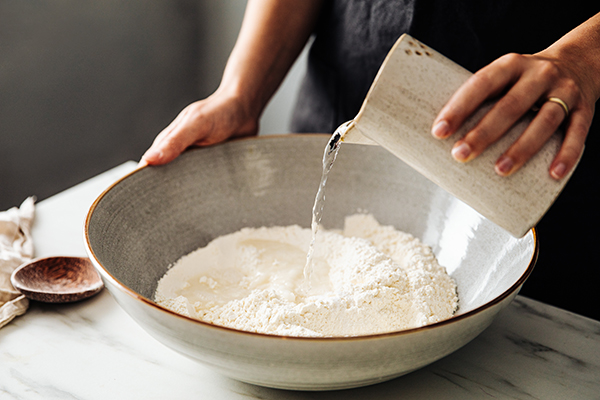Almost all baked goods require some type of flour and as all bakers know, baking is a science as much as an art — it requires precise ingredients and measurements to get the desired texture and taste.
Our definitive guide to flour will help you pick the one that suits your dietary needs.
If you want to bake better-for-you bread or dabble in gluten-free treats, you might be surprised that the recommended flours for these two health goals aren’t the same.
“It really depends on what your health goals are with nutrition,” says Natalie Welch, M.S., R.D.N. “In general though, whole-wheat flour is a great choice, as it still retains the bran (fiber) and germ (nutrient store-house) of the wheat kernel.”
Read on for a breakdown of the different types of flour and their uses.
All-Purpose Flour
The name explains how versatile this flour is. Made from wheat flour that’s been refined to remove the bran and germ, all-purpose flour (a.k.a., white flour or AP flour) can create flaky pie crusts, tender muffins, and chewy cookies.
“Good for traditional baking and fun treats, there’s not a lot of good nutrition here, as it’s mainly carbs, not a lot of fiber, and not a lot of protein,” explains Quyen Vu, Beachbody Culinary Nutrition Specialist. “It’s considered a refined flour.”
Reserve it for special occasion baking rather than everyday use.
Almond Flour
Made from peeled, blanched almonds, almond flour is gluten-free with a lightly sweet, nutty taste.
Since it lacks gluten, it can’t help hold baked goods together the way wheat flour can.
Compared with all-purpose flour, almond flour is more caloric and contains more fat, says Vu, and it can lead to denser baked goods.
Use almond flour in small amounts with other flours, or try it in our Mini Chocolate Cherry Cheesecake Bites.
Coconut Flour
Another gluten-free, grain-free option that’s popular among the keto and Paleo clubs, coconut flour is made from desiccated, ground coconut.
It’s not as high in calories as almond flour, says Vu, but can make baked goods dense.
Coconut flour can also have a strong taste, so keep that in mind when swapping it into recipes. Learn more about using coconut flour.
Gluten-Free Flours
Flour made from wheat, rye, and barley contains a naturally occurring protein called gluten, which helps bind ingredients and adds structure and strength.
For those who can’t tolerate gluten, there are plenty of gluten-free flour options, including rice, oat, quinoa, millet, bean, pea, cassava, or lentil flour.
Some gluten-free flours are also whole-grain flours.
If you have a gluten allergy or sensitivity, Welch recommends looking for a gluten-free option that has at least 4 grams of fiber per serving.
Check the label of gluten-free flour blends, as they can vary. Our gluten-free flour guide can help you pick the right one for your project.
Whole-Wheat Flour
Made from hulled wheat berries, this fiber-filled flour (13 grams per 100 grams!) can be used in place of all-purpose flour in almost every dish — even pumpkin pie.
Using 100% whole-wheat flour can make cookies and breads denser and drier.
Offset that by adding 2 extra tablespoons of liquid per cup of whole-wheat flour, suggests PJ Hamel, a baker and food writer.
White whole-wheat flour is made from hulled white spring wheat. Use it for a milder taste and color instead of whole-wheat flour.
Other Wheat-Based Flours
At the grocery store, you’ll see all sorts of other wheat flours: bread flour, cake flour, pastry flour, etc. These are best used for what their name implies.
- Bread flour is high in gluten to give dough structure and strength.
- Cake and pastry flour have a finer texture to yield a soft crumb. Look for whole-wheat pastry flour for extra fiber and protein (compared with the refined flour version).
- Semolina flour is coarse and often used for couscous, pasta, or gnocchi.
Alternative Flours
This category encompasses all non-wheat flours.
From the aforementioned almond and coconut flours to pea and chickpea flours to ancient grain flour (quinoa, barley, teff, or spelt), these flours tend to be used most often in gluten-free baking (as long as they’re gluten-free).
These flours can contribute more protein and fiber to recipes.
Feel free to get creative with recipes, but know that it’ll take some experimenting to get the texture and taste you crave.
“If you’re trying to sub a ‘healthier’ flour (with more protein and fiber) for a recipe that calls for a white refined flour, you will definitely have to play with the amounts,” says Vu. “It’s not a direct 1-to-1 substitute if you want to get the same or similar product.”



